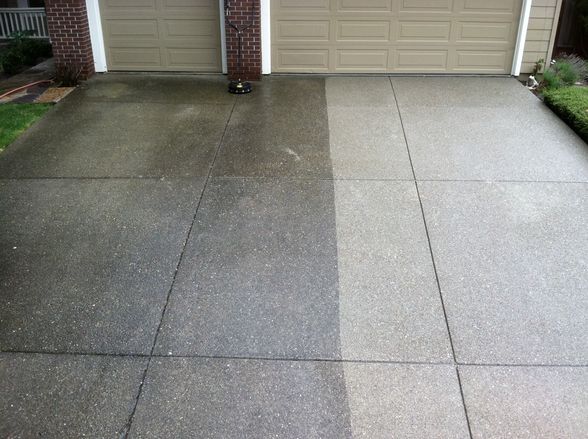
Concrete surfaces—whether it’s a driveway, patio, or decorative walkway—often get sealed or coated to boost appearance and protect against the elements. But when those surfaces get dirty or stained, many homeowners reach for the pressure washer. 💦
So here’s the big question:
Does pressure washing damage concrete sealants or coatings?
The short answer:
✅ Yes, it can—but it doesn’t have to. The effect depends on how you pressure wash, what kind of sealer was used, and how old the coating is.
Let’s explore how to clean sealed concrete safely without ruining your finish—or shortening its lifespan. 🧼🧱
🔒 What Do Sealants and Coatings Do?
Before we dive into pressure washing techniques, it’s helpful to understand why sealants and coatings are even used:
- 🛡️ Protect against stains: Like oil, rust, and mold
- 💧 Reduce water absorption: Prevents freeze/thaw damage
- 🌟 Enhance color and gloss: Especially with stamped or decorative concrete
- 🧬 Extend lifespan: Protects from UV rays, wear and tear
Most coatings fall into two categories:
- Penetrating Sealers: Soak into the concrete and form a chemical bond
- Film-Forming Sealers: Sit on the surface like acrylics or epoxies, creating a glossy or matte finish
Both types can be affected by improper pressure washing.
🚿 How Pressure Washing Can Harm Sealed Concrete
Pressure washing uses high-powered water to blast away dirt, but that force can also:
- Strip away film-forming sealants prematurely
- Etch or degrade the surface if too close
- Cause delamination or flaking in acrylic coatings
- Create streaks or uneven gloss if water pressure isn’t consistent
Older or poorly applied sealant is especially vulnerable.
🧨 The #1 mistake? Using a narrow-tip nozzle (like 0° or 15°) at full PSI directly on the surface. That’s practically a guaranteed way to cause damage.
✅ Best Practices: Pressure Washing Sealed Concrete Safely
To protect your sealant while still getting a great clean, follow these guidelines:
🔧 1. Use the Right Pressure Settings
- Stick to 1,200–2,000 PSI
- Avoid the temptation to crank it up for tough stains
- For delicate coatings (like stamped concrete), go even lower: 1,000–1,500 PSI
🔫 2. Choose a Wide-Angle Nozzle
- Use a 25° or 40° tip
- This helps spread the force and avoids stripping or gouging
Browse Amazon Here For Top Rated Power Washers And Accessories
↔️ 3. Maintain Distance
- Stay 12–18 inches from the surface
- Move in sweeping motions, not back-and-forth “scrubbing” blasts
🧴 4. Pre-Treat Stains Instead of Blasting
- Use a concrete-safe degreaser or mild detergent
- Let it sit 5–10 minutes before rinsing
- This reduces the need for aggressive spraying
🌀 5. Consider a Surface Cleaner Attachment
- These tools evenly distribute pressure
- Great for driveways and large patios
- They help avoid swirl marks or unsealed patches
📅 When Was It Last Sealed?
The age of the sealer matters more than most people think.
- Freshly sealed concrete (under 3 months) is especially sensitive
- Most sealers need at least 30 days to fully cure—avoid pressure washing during that window
- If your coating is older than 2–3 years, it may already be wearing off and less prone to damage—but also due for reapplication
💡 Tip: If water no longer beads up on the surface, your sealer may be worn out anyway.
🧪 How to Test If Your Concrete Is Still Sealed
Here’s a simple test:
- Pour a small cup of water on the surface
- Watch what happens
- Beads up or runs off? The sealant is still doing its job ✅
- Soaks in quickly? The sealant has likely broken down ❌
If the water soaks in, pressure washing won’t harm the nonexistent sealer—but it’s time to reseal after cleaning.
🛠️ What If You Accidentally Damage the Coating?
Don’t panic. If pressure washing caused patchy, dull, or worn spots:
- Clean the entire surface thoroughly
- Let it dry for 24–48 hours
- Apply a fresh layer of sealer, preferably the same type used before
- Use a sprayer or roller for even coverage
Some areas may require light sanding or acid etching if bubbling or flaking occurred.
🔄 Maintenance Tips for Sealed Concrete
- 🧼 Pressure wash no more than twice a year
- 🧽 Sweep regularly and spot-clean spills promptly
- ☀️ Avoid sealing in full sun—heat can cause bubbling or uneven adhesion
- 🛢️ Re-seal every 2–4 years, depending on weather exposure and traffic
With the right balance of maintenance and gentle cleaning, your concrete will stay protected and beautiful for years.
✅ Final Thoughts
So, does pressure washing affect concrete sealants or coatings?
🔑 It can— but it doesn’t have to.
As long as you:
- Use proper PSI
- Select the right nozzle
- Avoid blasting too close
- Pre-treat stains and work carefully…
You’ll remove dirt without stripping away the protection that keeps your concrete strong and stain-free. 🧱💪
Browse Amazon Here For Top Rated Power Washers And Accessories






